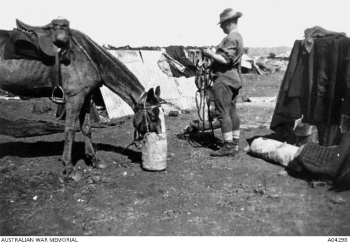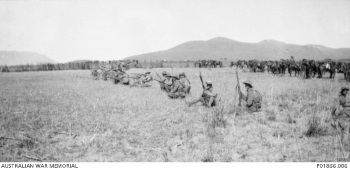From soon after its acquisition by Britain during the Napoleonic wars, the southern tip of Africa had been shared between British colonies and independent republics of Dutch–Afrikaner settlers, known as Boers. The relationship between the British and the Boers was an uneasy one, with Britain extending its control by annexing Natal in 1845, although London did recognise the two republics in two treaties in the 1850s. The discovery of gold and diamonds in the Boer republics in the 1880s further intensified the rivalry, particularly as British subjects flooded into the Boer territories in search of wealth.
The rights of British subjects in Boer territory, British imperial ambition, and the Boer desire for to stay outside the British Empire all caused more friction, which in 1899 provoked the Boers to attack in order to forestall what they saw as an impending British conquest.
As part of the British Empire, the Australian colonies offered troops for the war in South Africa. Australians served in contingents raised by the six colonies or, from 1901, by the new Australian Commonwealth. For a variety of reasons many Australians also joined British or South African colonial units in South Africa: some were already in South Africa when the war broke out; others either made their own way or joined local units after their enlistment in an Australian contingent ended.
Australians served mostly in mounted units formed in each colony before despatch, or in South Africa itself. The Australian contribution took the form of five waves. Colonial troops were valued for their ability to shoot and ride, and in many ways performed well in the open war on the veldt. There were significant problems, however, with the relatively poor training of Australian officers, with contingents generally arriving without having undergone much training and being sent on campaign immediately.
Men from the 2nd South Australian (Mounted Rifles) Contingent, who fought in the Boer War. Third from left is Trooper Harry "The Breaker" Morant. South Africa, c. 1900.
The conflict in South Africa is generally divided into three phases:
1.The early phase, from October to December 1899, when the British armies, mainly infantry, were defeated or besieged by highly mobile Boer mounted troops
2.The second phase, from December 1899 until September 1900, which involved a British counter-offensive, resulting in the capture of most of the major towns and cities of South Africa
3.The third and longest phase, from September 1900 to May 1902, when the war was mainly a guerrilla conflict between British mounted troops and Boer irregulars.
The outbreak of war had long been expected in both Britain and Australia. Believing that conflict was imminent, Queensland had offered troops in July, and the same month Britain had requested the participation of New South Wales and Victoria.
The first groups arrived in South Africa between November 1899 and March 1900; the second between December 1899 and February 1900; the third between April and May 1900; and the fourth between May and June 1900. The 4th Tasmanian, 6th Queensland, South Australian, and Western Australian contingents did not reach South Africa until March–April 1901. A further three contingents were raised by the new Commonwealth in 1901, but as they did not embark until 1902, most arrived too late for any action. Indeed, some were still at sea when the war ended on 31 May 1902.
The first Australian troops arrived in South Africa in December 1899, too late to become involved in the serious British defeats of “black week” (10–17 December), when 2,300 men were killed or wounded by the Boers in three separate engagements. Five hundred members of the Queensland Mounted Infantry and the NSW Lancers took part in the relief of Kimberley in February 1900, and men of the NSW Mounted Rifles played a minor part in the last major battle of the war, at Paardeberg, in the same month.
Conditions for both soldiers and horses were harsh. Without time to acclimatise to the severe environment and in an army with a greatly over-strained logistic system, the horses fared badly. Many died, not just in battle but of disease, while others succumbed to exhaustion and starvation on the long treks across the veld.

In the NSW Imperial Bushmen camp, South Africa, 1900
After September 1900, by which time the war had become mainly a guerrilla conflict, Australian troops were deployed in sweeping the countryside and enforcing the British policy of cutting the Boer guerrillas off from the support of their farms and families. By mid-1901 the war for the Australians was characterised by long rides, often at night, followed by an attack on a Boer farmhouse or encampment (laager) at dawn. The skirmishes were often minor, involving small Boer forces quickly overwhelmed by superior numbers. There were occasional fights between the Australians and larger Boer forces, but encounters with Boer commandos were rare.
The experience of the NSW Mounted Rifles in the last five months of 1901 was said to be typical: they trekked almost 3,000 kilometres and were involved in 13 skirmishes for the loss of five dead and 19 wounded. They reported killing 27 Boers, wounding 15 and capturing 196. The men spent long periods in the saddle with few opportunities to bathe or change their clothes; lice were a constant problem. Temperatures on the veld ranged from relentless heat during the day to freezing cold at night.

Members of E Company, 5th Contingent, Victorian Mounted Rifles, in action against the Boers in front of the Pongola Bosch, October 1901
It is generally thought that about 16,000 Australians fought in the Boer War. The nature of the conditions under which the war was fought can be deduced from the fact that in the Australian contingents, 282 died in action or from wounds sustained in battle, while 286 died from disease and another 38 died of accident or other unknown causes. Six Australians received the Victoria Cross in South Africa, and many others received other decorations.
Sources
P. Dennis, J. Grey, E. Morris, R. Prior, and J. Connor, The Oxford companion to Australian military history, Melbourne, Oxford University Press, 1995
Kit Denton, For Queen and Commonwealth: Australians at war, vol. 5, Sydney, Time–Life Books Australia, 1987
L. Field, The forgotten war: Australian involvement in the South African conflict of 1899–1902, Carlton, Melbourne University Press, 1979
J. Grey, A military history of Australia, Melbourne, Cambridge University Press, 1990
Pembroke Lathrop Murray, Official records of the Australian military contingents to the war in South Africa, 1899-1902, Melbourne, Government Printer, 1911
Craig Wilcox, Australia’s Boer War: the war in South Africa, 1899–1902, Melbourne, Oxford University Press 2002
Source: www.awm.gov.au/articles/atwar/boer (accessed 13 June 2019)